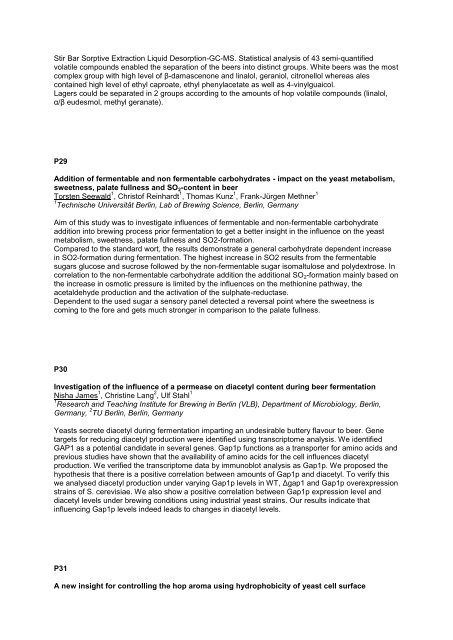here - the 34th European Brewery Convention
here - the 34th European Brewery Convention
here - the 34th European Brewery Convention
You also want an ePaper? Increase the reach of your titles
YUMPU automatically turns print PDFs into web optimized ePapers that Google loves.
Stir Bar Sorptive Extraction Liquid Desorption-GC-MS. Statistical analysis of 43 semi-quantified<br />
volatile compounds enabled <strong>the</strong> separation of <strong>the</strong> beers into distinct groups. White beers was <strong>the</strong> most<br />
complex group with high level of β-damascenone and linalol, geraniol, citronellol w<strong>here</strong>as ales<br />
contained high level of ethyl caproate, ethyl phenylacetate as well as 4-vinylguaicol.<br />
Lagers could be separated in 2 groups according to <strong>the</strong> amounts of hop volatile compounds (linalol,<br />
α/β eudesmol, methyl geranate).<br />
P29<br />
Addition of fermentable and non fermentable carbohydrates - impact on <strong>the</strong> yeast metabolism,<br />
sweetness, palate fullness and SO 2 -content in beer<br />
Torsten Seewald 1 , Christof Reinhardt 1 , Thomas Kunz 1 , Frank-Jürgen Methner 1<br />
1 Technische Universität Berlin, Lab of Brewing Science, Berlin, Germany<br />
Aim of this study was to investigate influences of fermentable and non-fermentable carbohydrate<br />
addition into brewing process prior fermentation to get a better insight in <strong>the</strong> influence on <strong>the</strong> yeast<br />
metabolism, sweetness, palate fullness and SO2-formation.<br />
Compared to <strong>the</strong> standard wort, <strong>the</strong> results demonstrate a general carbohydrate dependent increase<br />
in SO2-formation during fermentation. The highest increase in SO2 results from <strong>the</strong> fermentable<br />
sugars glucose and sucrose followed by <strong>the</strong> non-fermentable sugar isomaltulose and polydextrose. In<br />
correlation to <strong>the</strong> non-fermentable carbohydrate addition <strong>the</strong> additional SO 2 -formation mainly based on<br />
<strong>the</strong> increase in osmotic pressure is limited by <strong>the</strong> influences on <strong>the</strong> methionine pathway, <strong>the</strong><br />
acetaldehyde production and <strong>the</strong> activation of <strong>the</strong> sulphate-reductase.<br />
Dependent to <strong>the</strong> used sugar a sensory panel detected a reversal point w<strong>here</strong> <strong>the</strong> sweetness is<br />
coming to <strong>the</strong> fore and gets much stronger in comparison to <strong>the</strong> palate fullness.<br />
P30<br />
Investigation of <strong>the</strong> influence of a permease on diacetyl content during beer fermentation<br />
Nisha James 1 , Christine Lang 2 , Ulf Stahl 1<br />
1 Research and Teaching Institute for Brewing in Berlin (VLB), Department of Microbiology, Berlin,<br />
Germany, 2 TU Berlin, Berlin, Germany<br />
Yeasts secrete diacetyl during fermentation imparting an undesirable buttery flavour to beer. Gene<br />
targets for reducing diacetyl production were identified using transcriptome analysis. We identified<br />
GAP1 as a potential candidate in several genes. Gap1p functions as a transporter for amino acids and<br />
previous studies have shown that <strong>the</strong> availability of amino acids for <strong>the</strong> cell influences diacetyl<br />
production. We verified <strong>the</strong> transcriptome data by immunoblot analysis as Gap1p. We proposed <strong>the</strong><br />
hypo<strong>the</strong>sis that t<strong>here</strong> is a positive correlation between amounts of Gap1p and diacetyl. To verify this<br />
we analysed diacetyl production under varying Gap1p levels in WT, Δgap1 and Gap1p overexpression<br />
strains of S. cerevisiae. We also show a positive correlation between Gap1p expression level and<br />
diacetyl levels under brewing conditions using industrial yeast strains. Our results indicate that<br />
influencing Gap1p levels indeed leads to changes in diacetyl levels.<br />
P31<br />
A new insight for controlling <strong>the</strong> hop aroma using hydrophobicity of yeast cell surface





